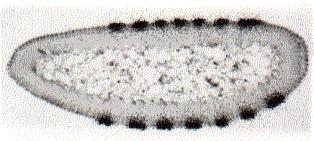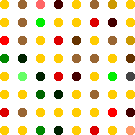The essence of multicellularity is the ability to express only certain portions of the genome in particular cells at particular times. This is done by the synthesis and assembly of transcription factors that turn on (and off) specific genes as required.
Many methods exist that enable one to detect a change in the whole organism as a result of gene expression in one part of it. For example, expression of the insulin gene in the beta cells of the islets of Langerhans can be monitored by measuring the level of insulin in the blood.
But there are no several ways in which the pattern of gene expression within individual cells can be monitored.
Most genes are expressed as proteins. The synthesis within a cell of a particular protein can be detected by antibodies able to bind to that protein. If the antibodies are coupled to a fluorescent or radioactive tracer, the cells making that protein will reveal themselves.

The first step in gene expression is the transcription of DNA into RNA. A molecule of single-stranded DNA complementary to a messenger RNA (mRNA) molecule will bind to it by Watson-Crick base pairing. If the DNA is radioactive, it will identify cells making that message.
This autoradiogram (courtesy of Philip Ingham) shows regions in the Drosophila embryo that have been labeled by radioactive DNA complementary to the sequence of the mRNA for the homeobox gene fushi-tarazu (ftz). It reveals 7 bands encircling the blastoderm. These represent regions that alternate with the 7 bands formed by the even-skipped (eve) gene (lower picture).
 One favorite reporter gene is the Z gene of the E. coli lac operon that encodes the enzyme beta-galactosidase.
One favorite reporter gene is the Z gene of the E. coli lac operon that encodes the enzyme beta-galactosidase.
| Link to discussion of the lac operon. |
An example:
Make Drosophila transgenic for recombinant DNA containing:Any cell with the transcription factors for turning on the even-skipped promoter will begin to make beta-galactosidase. Given the proper substrate, the enzyme produces a colored product.
This photomicrograph (courtesy of Peter A. Lawrence and Blackwell Scientific Publications, Ltd.) shows 7 bands of this colored product identifying the cells that were expressing the even-skipped gene. This event was "reported" by the lacZ gene. The 7 dark stripes reveal regions that alternate with the 7 bands formed by the cells expressing fushi-tarazu (top picture).
In nature, green fluorescent protein (GFP) is produced by, Aequorea victoria, the Pacific Northwest jellyfish. The protein has become of great interest to cell and molecular biologists because it can reveal gene expression in living cells.
This is done by fusing the gene for GFP to the gene whose expression you are interested in. When that gene is turned on in a cell, not only is its protein synthesized, but GFP is synthesized as well. Illuminating the cells with near-ultraviolet light causes them to fluoresce a bright green. In this way, the experimenter can see when and where the gene is expressed in the living organism.
All the methods described so far are limited to monitoring the expression of one or, at most, a few genes. But as conditions change in a cell, the transcription and translation of literally hundreds of genes may be altered.
Thanks to the marriage of
This work was reported by V. R. Iyer, et al in the 1 January 1999 issue of Science. It involved the monitoring the expression of 6347 different genes.
| Welcome&Next Search |